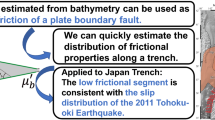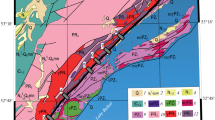Abstract
Structural analyses of the angles of frictional ‘lock-up’ for fault sets that have become progressively misoriented, together with field observations from seismology, geomorphology, and borehole stress measurements, suggest that Byerlee friction coefficients (0.6<μ<0.85) are widely applicable to natural sliding surfaces with displacements of up to a few kilometres in the upper crust, from the surface of the earth to seismogenic depths. Extensional normal faults operating under presumed vertical trajectories of extreme compressive stress provide some of the best evidence for frictional lock-up followed by the initiation of new favorably oriented faults, but similar lock-up phenomena also occur in thrust and strike-slip fault systems.
However, extensional detachments which appear to have formed and remained active at very low dips (<15°) lie well outside the dip range of currently active normal faults, requiring stress trajectories that deviate significantly from the vertical and horizontal during their initiation and perhaps also during their continued reactivation. Other conspicuous exceptions to the pattern of frictional lock-up expected from Byerlee friction are major transform structures, such as the San Andreas fault in California, which remain active though oriented at high angles to the maximum principal compression. On the basis of the evidence afforded by the lower displacement faults, the apparent weakness of such structures seems most likely to arise from locally elevated fluid pressure, rather than from the presence of anomalously low-friction material within the fault zones.
Similar content being viewed by others
References
Anderson, E. M. (1905),The Dynamics of Faulting, Trans. Edin. Geol. Soc.,8, 387–402.
Anderson, E. M.,The Dynamics of Faulting and Dyke Formation with Application to Britain, 2nd edn. (Oliver and Boyd, Edinburgh 1951) 206 pp.
Angevine, C. L., Turcotte, D. L., andFurnish, M. D. (1982),Pressure Solution Lithification as a Mechanism for the Stick-slip Behavior of Faults, Tectonics1, 151–160.
Axen, G. J. (1992),Pore Pressure Stress Increase, and Fault Weakening in Low-angle Normal Faulting, J. Geophys. Res.97, 8979–8991.
Batzle, M. L., andSimmons G. (1977),Geothermal Systems: Rocks, Fluids, Fractures. American Geophysical Union Monograph20, 233–242.
Boyer, S. E.,Geometric evidence for synchronous thrusting in the southern Alberta and northwest Montana thrust belts. InThrust Tectonics (ed. McClay, K. R.) (Chapman & Hall, London 1992) pp. 377–390.
Boyer, S. E., andElliot, D. (1982),Thrust Systems, Am. Assoc. Petrol. Geol. Bull.66, 1196–1230.
Bruhn, R., Yusas, M. R., andHuertas, F. (1982),Mechanics of Low-angle Normal Faulting: An Example from Roosevelt Hot Springs Geothermal Area, Utah, Tectonophys.86, 343–361.
Butler, R. W. H. (1983),Balanced Cross-sections and their Implications for the Deep Structure of the Northwest Alps, J. Struct. Geol.5 125–137.
Byerlee, J. D. (1978),Friction of Rocks, Pure Appl. Geophys.116, 615–626.
Byerlee, J. D. (1990),Friction, Overpressure, and Fault-normal Compression, Geophys. Res. Lett.17, 2109–2112.
Byerlee, J. D. (1993),Model for Episodic Flow of High-pressure Water in Fault Zones before Earthquakes, Geology21, 303–306.
Carson, M. A. (1977),Angles of Repose, Angles of Shearing Resistance, and Angles of Talus Slopes, Earth Surface Processes2, 363–380.
Carson, M. A., andKirkby, M. J.,Hillslope Form and Processes (Cambridge University Press, Cambridge 1972) 475 pp.
Chen, W.-P., andMolnar, P. (1983),Focal Depths of Intracontinental and Intraplate Earthquakes and their Implications for the Thermal and Mechanical Properties of the Lithosphere, J. Geophys. Res.88, 4183–4214.
Dieterich, J. H. (1972),Time-dependent Friction in Rocks, J. Geophys. Res.,77, 3690–3697.
Dieterich, J. H. (1979),Modelling of Rock Friction: 1. Experimental Results and Constitutive Equations, J. Geophys. Res.84, 2161–2168.
Doser, D. I., andSmith, R. B. (1989),An Assessment of Source Parameters of Earthquakes in the Cordillera of the Western United States. Bull. Seismol. Soc. Am.79, 1383–1409.
Elliot, D. (1976),The Energy Balance and Deformation Mechanisms of Thrust Sheets, Phil. Trans. R. Soc. Lond.A 283, 289–312.
Fournier, R. O. (1991),The Transition from Hydrostatic to Greater than Hydrostatic Fluid Pressure in Presently Active Continental Hydrothermal Systems in Crystalline Rock, Geophys. Res. Lett.18, 955–958.
Hill, D. P. (1993),A Note on Ambient Pore Pressure, Fault-confined Pore Pressure, and Apparent Friction, Bull. Seismol. Soc. Am.83, 583–586.
Jackson, J. A. (1987),Active Normal Faulting and Crustal Extension, Geol. Soc. Lond. Spec. Publ.28, 3–17.
Jaeger, J. C., andCook, N. G. W.,Fundamentals of Rock Mechanics (Chapman and Hall, London 1979) 591 pp.
Jamison, D. B., andCook, N. G. W. (1980),Note on Measured Values for the State of Stress in the Earth's Crust, J. Geophys. Res.85, 1833–1838.
John, B. E. (1987),Geometry and Evolution of a Mid-crustal Extensional Fault System: Chemehuevi Mountains, Southeastern California, Geol. Soc. Lond. Spec. Publ.28, 313–335.
Koons, D. (1955),Cliff Retreat in the Southwest United States, Am. J. Sci.253, 44–52.
McCaig, A. M., andMcClelland, E.,Paleomagnetic techniques applied to thrust belts. InThrust Tectonics (ed. McClay, K. R.) (Chapman & Hall, London 1992), pp. 209–216.
McClay, K. R., Insley, M. W., andAnderton, R. (1990),Inversion of the Kechika Trough, Northeastern British Columbia, Canada, Geol. Soc. Lond. Spec. Publ.44, 235–257.
Miller, E. L., Gans, P. B., andGaring, J. (1983),The Snake Range Decollement: An Exhumed Mid-Tertiary Ductile-brittle Transition, Tectonics2, 239–263.
Miller, M. G. (1991),High-angle Origin of the Currently Low-angle Badwater Turtleback Fault, Death Valley, California, Geology19, 372–375.
Morley, C. K. (1990),Basin Inversion in the Osen-Røa Thrust Sheet, Southern Norway, Geol. Soc. Lond. Spec. Publ.44, 259–273.
Morrow, C., Radney, B., andByerlee, J.,Frictional strength and the effective pressure law of montmorillonite and illite clays. InEarthquake Mechanics and Transport Properties of Rocks (eds. Evans, B. and Wong, T. F.) (Academic Press, London 1992) pp. 69–88.
Mount, V. S. andSuppe, J. (1987),State of Stress near the San Andreas Fault: Implications for Wrench Tectonics, Geology15, 1143–1146.
Mount, V. S., andSuppe, J. (1992),Present-day Stress Orientations Adjacent to Active Strike-slip Faults: California and Sumatra, J. Geophys. Res.97, 11,995–12,013.
Nur, A., Ron, H., andScotti, O. (1986),Fault Mechanics and the Kinematics of Block Rotations, Geology14, 746–749.
Nur, A., Ron, H., andScotti, O. (1989),Kinematics and Mechanics of Tectonic Block Rotations, Am. Geophys. Union Geophys. Mon.49, 31–46.
Nur, A., Ron, H., andBeroza, G. (1993),Landers-Mojave Earthquake Line: A New Fault System, GSA Today3, 253, 256–258.
Parsons, T., andThompson, G. (1993),Does Magmatism Influence Low-angle Normal Faulting, Geology21, 247–250.
Price, N. J., andCosgrove, J. W.,Analysis of Geological Structures (Cambridge University Press, Cambridge 1990), 502 pp.
Proffett, J. M. (1977),Cenozoic Geology of the Yerington District, Nevada, and Implications for the Nature and Origin of Basin and Range Faulting, Bull. Geol. Soc. Am.88, 247–266.
Rice, J. R.,Fault stress states, pore pressure distributions, and the weakness of the San Andreas fault. InEarthquake Mechanics and Transport Properties of Rocks (eds. Evans, B., and Wong, T. F.) (Academic Press, London 1992) pp. 475–503.
Roberts, S., andJackson, J. (1991),Active Normal Faulting in Central Greece: An Overview, Geol. Soc. Lond. Spec. Publ.56, 125–142.
Scott, R. J., andLister, G. S. (1992),Detachment Faults: Evidence for a Low-angle Origin, Geology20, 833–836.
Sibson, R. H. (1974),Frictional Constraints on Thrust, Wrench, and Normal Faults, Nature,249, 542–544.
Sibson, R. H. (1983),Continental Fault Structure and the Shallow Earthquake Source, J. Geol. Soc. Lond.140, 741–767.
Sibson, R. H. (1985),A Note on Fault Reactivation, J. Struct. Geol.7, 751–754.
Sibson, R. H. (1990),Rupture Nucleation on Unfavorably Oriented Faults, Bull. Seismol. Soc. Am80, 1580–1604.
Sleep, N. H., andBlanpied, M. L. (1992),Creep, Compaction, and the Weak Rheology of Major Faults, Nature,359, 687–692.
Stesky, R., Brace, W., Riley, D., andRobin, P-Y. (1974),Friction in Faulted Rock at High Temperature and Pressure, Tectonophys.23, 177–203.
Tanner, P. W. G., The duplex model: implications from a study of flexural slip duplexes In:Thrust Tectonics (ed. McClay, K. R.) (Chapman and Hall London 1992) pp. 201–208.
Wilcox, W. S. D., Purdy, G. M., andSolomon, S. C. (1992),Microearthquake Evidence for Extension Across the Kane Transform Fault, J. Geophys. Res.95 15,439–15,462.
Zoback, M. D., Apel, R., Baumgartner, J., Brudy, M., Emmerman, R., Engeser, B., Fuchs, K., Kessels, W., Rischmuller, H., Rummel, F. andVernik, L. (1993),Upper Crustal Strength Inferred from Stress Measurements to 6 km Depth in the KTB Borehole Nature365, 633–635.
Zoback, M. D., andHealy, J. H. (1984),Friction, Faulting, and in situ Stress, Ann. Geophys.2, 689–698.
Zoback, M. D., andHealy, J. H. (1992),In situ Stress Measurements to 3.5 km Depth in the Cajon Pass Scientific Research Borehole: Implications for the Mechanics of Faulting, J. Geophys. Res.97, 5039–5057.
Zoback, M. D., Zoback, M. L., Mount, V. S., Suppe, J., Eaton, J. P., Healy, J. H., Oppenheimer, D., Reasenberg, P., Jones, L., Raleigh, C. B., Wong, I. G., Scotti, O., andWentworth, C. (1987),New Evidence on the State of Stress of the San Andreas Fault System, Science238, 1105–1111.
Zoback, M. L. (1989),State of Stress and Modern Deformation of the Northern Basin and Range Province, J. Geophys. Res.94, 7105–7128.




